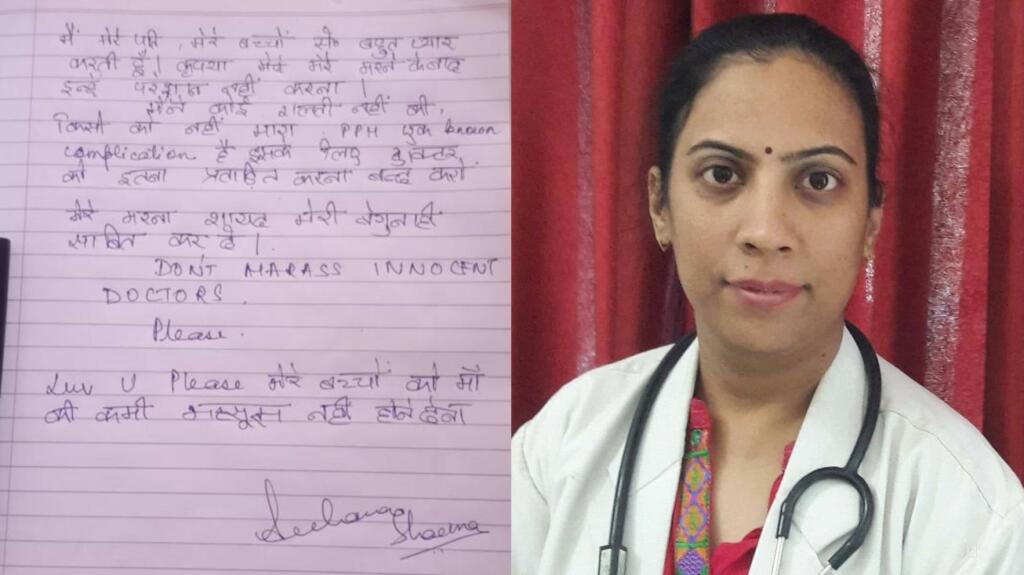Medicine is a noble profession. We rush to doctors in times of pain, distress, and suffering. Doctors are often addressed with prefixes like ‘Sahab’ or ‘Madam’ unconsciously out of respect. But the same doctors’ fraternity is subjected to abuse and violence every then and now. India has witnessed many uproars on the issue of violence against doctors. Yet the most unfortunate thing is that there are no amendments and Dr Archana Sharma’s case advocates for that.
Also Read: Why both the Centre and Supreme Court are to blame for the doctors’ protests
Distressed Rajasthan gynaecologist commits suicide
“My death will perhaps prove my innocence,” This was mentioned in a suicide note of not some history-sheeter but a gynaecologist, Dr Archana Sharma who committed suicide after she was accused of medical negligence.
Dr Archana Sharma was based in Dausa, Rajasthan, where she along with her husband Dr Suneet Upadhyay were running Anand hospital. According to reports, a 22-year-old pregnant woman was brought to the hospital on 28th March with labour pain, and she passed away during treatment due to Postpartum Haemorrhage, a rare but known complication.
Complication Vs Negligence
Reportedly, the patient lost her life due to excessive bleeding mentioned as PPH (postpartum haemorrhage) in medical terms, a rare but well-known complication. But Dr Sharma was held responsible for the occurrence of the complication and was accused of negligence.
An FIR was registered at the local police station against her under Section 302 of the Indian Penal Code (IPC) and was charged with attempt to murder.
According to Dr Sharma’s suicide note, the patient passed away during a normal procedure. Dr Sharma had an illustrious career, she was working as an associate professor and unit head in the government medical college, Gandhinagar before she decided to open her own hospital along with her husband. She was a mother of two kids. What was the reason that forced a well-read gynaecologist, a mother to give her life?
The answer is simple, the lack of public awareness that stops them from differentiating between complication and negligence.
Also Read: Salute to doctors for their fight with the pandemic
Medical fraternity subjected to constant violence
Dr Archana Sharma allegedly committed suicide as she was not able to handle the pressure of the FIR and accusations of negligence. As per her suicide note, Dr Sharma was subjected to mental harassment. The tragic incident of Dr Archana Sharma is not a lone incident, and the medical fraternity is subjected to constant violence and abuse. Doctors bear not only torturous long hours shifts but are also accused of negligence every now and then. In this row, even medical complications are barred. And Dr Sharma’s suicide has initiated a debate around the safety of medical professionals at workplace across the country and has shed light on their grievances.
What data says about harassment of Doctors
Poor working conditions, harassment from hospital management, long shifts and abuse and violence from patients’ families, are some commonly reported grievances of the medical fraternity. Though they form hard-hitting headlines but soon fade away in due course of time.
According to a survey conducted by Indian Medical Association, more than 75% of doctors face violence at workplace. This violence against doctors varies from verbal abuse to physical assault. Another study conducted in 2007 suggests that one-third of doctors face verbal abuse at workplace.
This doesn’t end here, 46% of doctors are stressed out due to fear of violence while 14% fear criminal prosecution.
The cost of harassment faced by medical fraternity
One might think that the impact of these kinds of violent practices is against the medical fraternity only. But the public is paying the cost and the larger implications will be on the public itself in the times to come. The medical fraternity has begun to play safe in fear, many times they deny admission to a critical patient fearing the after-effects, while many resort to referring the patients to higher authorities which sometimes costs the life of the patient due to delay in medical attention.
In India, there is only one doctor for every 1,457 people. Though there have been constant efforts by the central government to raise this number, the projects are still in pipeline or are yet to be launched. This number clearly advocates for the urgent need to counsel the patients and the people who escort them. What else is also necessary is a stringent law governing against harassment of doctors.
